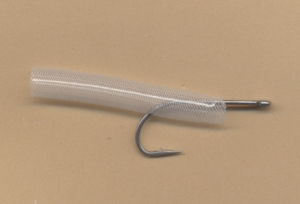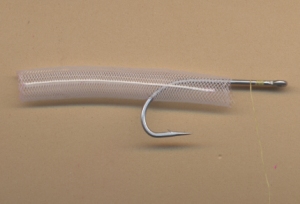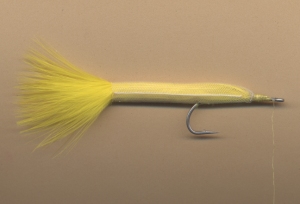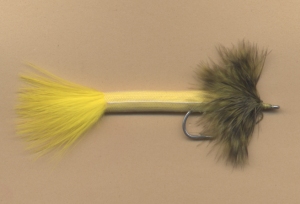
The Aleph may or may not look like anything in nature but it certainly attracts fish. It can be tied in a variety of sizes and colors. Salt water fishermen say it looks something like a squid. Fresh water fishermen say it looks something like a crayfish. It's like Hamlet's cloud: the fish see in it what they want to see and so do the fishermen. I recommend it for striped bass, tarpon, largemouth bass, snook, pike, and other voracious and curious fish.
Recommended colors include black, blue/white, chartreuse, chartreuse/black, red/yellow, red/orange, and white
Dressing for the Aleph
|
Hook: |
M34007, D2546, or equivalent, size 2 to 3/0 |
|
Thread: |
6/0, Danville's, color to vary |
Body: |
1/4 or 1/3 inch corsair tubing (see tying notes) |
|
Tail and Insert: |
Marabou plume, glimmer, or combination |
|
Collar: |
Saddle feathers that include the downy feathers near the butt |
 Cut a three to four inch length of corsair tubing. Thread it onto the hook in one of two ways. Either way, the front end of the tubing should extend to a point just short of the hook eye.
Cut a three to four inch length of corsair tubing. Thread it onto the hook in one of two ways. Either way, the front end of the tubing should extend to a point just short of the hook eye.
-
Method 1: Push the eye of the hook through the tubing mesh midway between the thread lines so that the tubing surrounds and covers the hook shank.
-
Method 2: Thread the tubing over the hook point, around the bend and over the shank.
 Attach your thread to the hook shank just behind the eye.
Attach your thread to the hook shank just behind the eye.
 Take a marabou plume and strip away some of the downy fibers from the butt end. Insert the butt into the rear of the corsair tubing. Push forward until the stem comes out the front end of the tubing. Draw the remainder of the feather through the tubing until the desired length of tail is achieved.
Take a marabou plume and strip away some of the downy fibers from the butt end. Insert the butt into the rear of the corsair tubing. Push forward until the stem comes out the front end of the tubing. Draw the remainder of the feather through the tubing until the desired length of tail is achieved.
Alternatively (or additionally) if you are using glimmer, draw the glimmer through the tubing using a lead wire or bobbin threader.
For larger flies or for a bushier tail, use two or even three plumes.
 Tie down the feather butt and/or glimmer and trim the excess. Tie down the front section of the tubing and trim off the excess.
Tie down the feather butt and/or glimmer and trim the excess. Tie down the front section of the tubing and trim off the excess.
 Take two or three saddle feathers that include some of their base fluff. Tie them in at the front end of the tubing and then wind them forward to form the collar. As you are winding them forward, stroke the fibers back towards the rear of the hook so that the winds lie down in that direction. Tie down the saddles and trim the excess. Wind on a neat thread head and whip finish.
Take two or three saddle feathers that include some of their base fluff. Tie them in at the front end of the tubing and then wind them forward to form the collar. As you are winding them forward, stroke the fibers back towards the rear of the hook so that the winds lie down in that direction. Tie down the saddles and trim the excess. Wind on a neat thread head and whip finish.
Paint eyes, if desired, and allow them to dry. Then cement the head.
Tying Notes
The Aleph is a strikingly handsome and different-looking fly. Jack first listed it in his book Flies for the 21st Century. Here are a few things to consider when tying it.
Corsair color: Which color of corsair to use depends on the effect you want to achieve. If you want the color of the marabou to show through the tubing, non-metallic white (which is actually translucent) is usually best. An exception to this is when using black marabou, in which case black corsair is a better choice.
"Sealing" the Corsair: On the Aleph, the rear end of the Corsair is left "open". That is to say, it is not cinched shut with thread as is done with some other Gartside Corsair patterns like the Floating Minnow. Genuine Corsair is pretty strong stuff an does not unravel easily. However, if you want to add a little extra insurance against the rear end unraveling, before threading the Corsair onto your hook, press the rear end lightly against a butter knife that has been heated briefly over an open flame. This will melt and "seal" the Corsair fibers. Alternatively, you can dip the rear end in some head cement (but not too much!).






